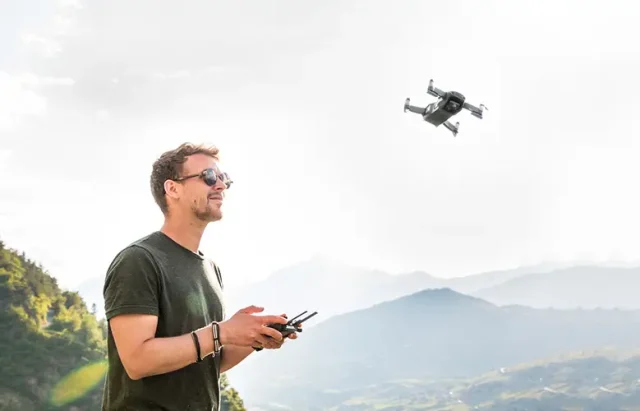
The future of drones is unfolding at a remarkable pace. From delivering packages to monitoring crops, inspecting power lines, elevating the quality of videos, and exploring ocean depths, drones are transforming industries and daily life in ways few could have imagined only a decade ago. Drones are becoming more versatile, intelligent, and ultimately an essential part in so many lives. Today, even underwater drones are making headlines, expanding the definition of what the drone can be and where it can go. So as we look ahead, let’s identify seven key trends and predictions shaping the next era of drone technology:
Enterprise Drones Taking Centre Stage
In the world of professional and industrial drones, the DJI Matrice 400 is standing out as a symbol of where the industry is heading. This enterprise flagship drone boasts an impressive 59-minute flight time, 6 kg payload capacity, and advanced obstacle sensing powered by LiDAR and mmWave radar. Its ability to operate in harsh weather conditions, perform ship-based takeoffs and landings, and support intelligent features like smart detection and AR projection makes it an indispensable tool for a wide array of applications, whether it’s emergency response, precision mapping, or complex construction oversight.
As these platforms continue to evolve and become even more capable, we can expect them to take on increasingly complex, high-stakes autonomous roles in our global infrastructure and emergency services. This trend underscores a broad move towards specialized, purpose-built drone solutions that integrate seamlessly into existing operational frameworks, which will drive efficiency and enhance safety.
AI and Autonomy
Artificial intelligence is rapidly transforming drones from remotely controlled gadgets to highly sophisticated pieces of autonomous equipment. Modern drones are leveraging AI and machine learning to process vast amounts of data in real time, meaning they can make split-second decisions, dynamically adjust to changing environmental conditions like wind shear, avoid complex obstacles, and even identify specific objects or individuals on the ground with precision. This monumental leap in intelligence is not only reducing the skill barrier for drone operators but, more importantly, empowering drones to tackle complex, dangerous, or repetitive tasks with significantly reduced human intervention.
Looking further into the future, this AI-driven autonomy will unlock capabilities that allow entire fleets of drones to coordinate intricate missions, monitor vast geographical areas continuously, and analyze data in real time. We’re already seeing this high level of sophistication in sectors such as agriculture, where drones equipped with AI can analyze multispectral imagery to assess crop health, detect diseases early, and optimize irrigation schedules. This has led to more sustainable and productive farming practices. Likewise, AI-powered drones in logistics have streamlined warehouse inventory management and optimized delivery routes. As AI capabilities continue their exponential growth, we can expect drones to become even more intelligent, indispensable, and to adapt and learn from their environments.
Drone Delivery Going From Novelty to Necessity
After years of promising prototypes and hurdles in regulation, drone delivery is taking off and moving towards mainstream adoption. Companies like Zipline and Wing are no longer just concepts, but are operational entities partnering with major retailers, pharmacies, and health care providers to deliver goods swiftly and efficiently. This method of delivery bypasses traditional traffic congestion, significantly reduces delivery times, and also provides a greener alternative by cutting down on carbon emissions associated with ground transportation.
The progress here doesn’t just involve the technological side of things, but also making regulatory breakthroughs. One such area, like the development of sophisticated traffic management systems, can mean a safe integration of a large volume of delivery drones into an existing airspace. In the very near future, drones will likely become a common and accepted sight in urban and rural skies, delivering an ever-expanding selection of items. The efficiency and environmental benefits offered by drone delivery could be transformative, particularly in communities in remote or underserved areas with limited access to traditional logistics networks, meaning a new era of on-demand logistics.
Underwater Drones Diving Deeper
Underwater drones, also known as autonomous underwater vehicles or remotely operated vehicles, are experiencing a significant surge in innovation and adoption, literally opening up new frontiers for exploration, research, and industrial applications beneath the waves. The global underwater drone market is projected to grow and is being driven by increasing demand across diverse sectors, including marine research, military and defense, offshore energy such as oil and gas, and critical environmental monitoring.
Underwater drones are capable of performing complex tasks due to being equipped with highly advanced sonar, sophisticated cameras, robotic manipulators, and AI-driven navigation systems. Continuous improvements in battery tech and more will make these drones even more capable and versatile.
Precision Agriculture
Drones are revolutionizing agriculture by enabling high levels of precision farming. Equipped with sensitive multispectral and hyperspectral cameras, LiDAR sensors, and advanced AI analytics, drones can meticulously monitor crop health, assess soil conditions, and precisely measure water usage across vast fields.
This granular data empowers farmers to optimize fertilizer application, pinpoint pest infestations, and more, leading to significant yield increases, reduced resource waste, and more sustainable farming practices.
What Is Next for Drones?
The next frontier holds even more exciting and almost unimaginable possibilities for drone tech. Swarm intelligence, for example, will enable large fleets of autonomous drones to work collaboratively on incredibly complex tasks such as conducting synchronized search and rescue operations, performing detailed environmental surveys, and even carrying out large-scale 3D mapping missions with unprecedented speed and accuracy.
Additionally, advances in edge computing will revolutionize drone operations by allowing them to process and analyze vast amounts of data directly on board and so much more. The future of drones is bright. As artificial intelligence, autonomous capabilities, and the reality of seamless connectivity continue, drones are going to become smarter, safer, and vital to the way we live, work, and interact with our world.
Whether you are a gadget enthusiast, business leader, or just captivated by how fast this tech is progressing, it is imperative to make sure that you see what’s going to happen. Drones are redefining industries and life that we’re only just beginning to comprehend.





